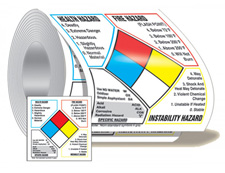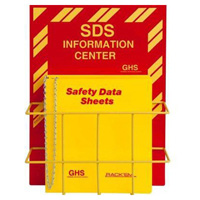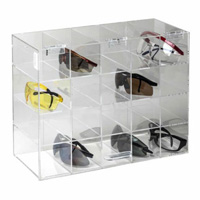



Find all of your laboratory and workplace safety supplies at Safety Emporium!
 Paresthesias |
 Glossary Index |
 Peroxide |
| MSDS Topics |
Free Sites | FAQ's | Regulations | Glossary | Software | Suppliers |
| Books | Forum | Poll | Fun stuff | Quiz | Store | |
| Understand your MSDS with the MS-Demystifier | Search ALL our MSDS info | |||||

Communicate workplace hazards with handy labels from Safety Emporium.
PEL's can be defined in two different ways as discussed in the OSHA regulation on air contaminants, 29 CFR 1910.1000:
TWA levels are usually lower than ceiling values. Thus, a worker may be exposed to a level higher than the TWA for part of the day (but still lower than the ceiling value) as long as he or she is exposed to levels below the TWA for the rest of the day. See 29 CFR 1910.1000 for the formulas used in the calculations.
Analyzing the specific health risks and performing the cost/benefit analyses needed to set a PEL is a time-consuming and labor-intensive endeavor. As a result, only ~470 substances have OSHA PEL's.
In 1989, OSHA decided that it was impractical to set PEL's for tens of thousands individual chemicals and enacted a generic rulemaking scheme that broke chemicals up into various categories. This methodology was challenged in court and in AFL-CIO v. OSHA, 965 F.2d 962 the 11th U.S. District Court of Appeals vacated (struck down) the 1989 PEL revisions stating "(1) OSHA failed to establish that existing exposure limits in the workplace presented significant risk of material health impairment or that new standards eliminated or substantially lessened the risk; (2) OSHA did not meet its burden of establishing that its 428 new permissible exposure limits (PELs) were either economically or technologically feasible."
Toxicological professionals generally disagree with both of those points. With respect to the first, there was substantial documentation to support OSHA's position, and with the respect to the second, performing an economic analysis for every chemical (there are well over 100,000 commodity chemicals in use in the US) for every industry is completely infeasible. In 58:35338-35351 of the Federal Regsister OSHA noted that "...OSHA continues to believe that many of the old limits which it will now be enforcing are out of date (they predate 1968) and not sufficiently protective of employee health based on current scientific information and expert recommendations. In addition, many of the substances for which OSHA has no PELs present serious health hazards to employees."

Your employees can stay informed and comply with OSHA regulations with SDS information stations and compliance products from Safety Emporium.
Regardless, OSHA was forced to revert to the older limits. This case clearly established that to set new PEL's OSHA would need to collect specific evidence for each substance so the risk/benefit analysis could be reviewed, and the resources required for that have never been made available and likely never will be available. More information on this legal case can be found under Further Reading below.
In theory, OSHA is continuing to perform risk assessment and feasibility analysis on air contaminants in light of this court ruling, using a risk-based prioritization to identify those substances which have the most significant impact on worker safety. But in the years since this ruling, OSHA has enacted or updated PEL's for just a handful of substances.
Just to confuse matters, this decision did not directly apply to the states and territories which administer their own OSHA-approved plans. Some of these states may retain the 1989 limits. Therefore, to maximize safety and minimize potential legal problems, it is best to compare the 1989 PELs for these substances with the ACGIH limits (TLV's), and comply with whichever is most protective.
Therefore, vacated PEL values may still appear on Safety Data Sheets because some states may have enacted statutes based on their values and because some employers or employees might prefer their larger margin of safety (or error, depending on your perspective) when setting their workplace exposure limits. Whatever values you find, always err on the side of safety and choose the lower one. Remember we always want to keep chemical exposures as low as reasonably achievable (ALARA).
NOTE: We may collect a share of sales or other compensation from the links in the following list:
PEL's and any other recommended exposure limits will appear on Section 8 (exposure controls/personal protection) of that material's Safety Data Sheet. PEL's are defined by OSHA in three tables:

Make your PPE readily available with safety dispensers from Safety Emporium.
In general, PEL's refer to substances that may be inhaled, although some can be absorbed through the skin or eyes. When working with materials that have an established PEL or TWA consult Section 8 (exposure controls/personal protection) of the SDS for use administrative and engineering controls to minimize the generation of a vapor or dust in the first place. If those controls are not sufficient, use the recommended personal protective equipment (PPE) such as gloves, dust masks, and respirators to limit your exposure to the chemicals.
Remember, exposure limits are not some magic threshold that define the border between safe and dangerous. A PEL that was acceptable in 1950 may be recognized as dangerously high today. Therefore, always do everything reasonable to limit the airborne airborne release of chemicals or dusts in the first place.
See also: action level, engineering controls, inhalation, Threshold Limit Values (TLV).
Additional definitions from Google and OneLook.
Entry last updated: Saturday, January 7, 2023. This page is copyright 2000-2025 by ILPI. Unauthorized duplication or posting on other web sites is expressly prohibited. Send suggestions, comments, and new entry desires (include the URL if applicable) to us by email.
Disclaimer: The information contained herein is believed to be true and accurate, however ILPI makes no guarantees concerning the veracity of any statement. Use of any information on this page is at the reader's own risk. ILPI strongly encourages the reader to consult the appropriate local, state and federal agencies concerning the matters discussed herein.